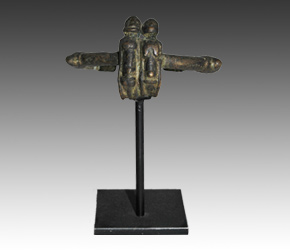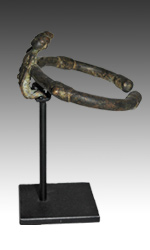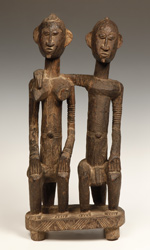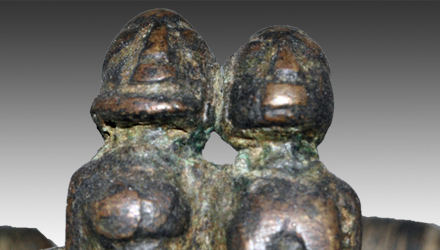Dogon Kneeling Couple Bracelet or Armband
 |
|
"Dogon believe a single creator called Amma established four sets of beings called Nommo, each embodying male and female traits. Illustrated in this bracelet is a Dogon man and woman, which can be interpreted as the Nommo or a Dogon married couple"
Adornment in the form of rings and bracelets comprises an integral part of the Dogon artistic heritage, which often portrays different aspects of daily life with special emphasis placed on what might be considered important moments during the life of individuals. Although this type of adornment may be distinctly Dogon in artistic style, the message inherent in such pieces typically transcends cultural and ethnic boundaries.
 |
|
The Dogon are strongly oriented toward harmony, which is reflected in both their rituals and artwork. For example, endemic to the Dogon is an elaborate system of greetings called sewa, which occurs whenever one Dogon person meets another. During sewa the person who initiates contact asks a series of questions from the person already there about his or her whole family. Once completed, the tables are turned and the questions are repeated. Invariably, the answer to these questions is the word 'sewa,' which means 'everything is fine.' This goes on repeatedly in Dogon villages all day, and because the word 'sewa' is so commonly heard in those villages, the Dogon are also known as “The Sewa People.”
The Dogon record their ancestry through a patrilineal system tracing the father’s lineage. Each Dogon community, or enlarged family, is headed by one male elder. This “chief” is usually the oldest living son of the most recently deceased, or the closest ancestor of the local branch of the family. In Dogon society, males can have as many as four wives; however, most men have only one wife, and it is rare to have more than two wives. Formally, wives only join their husband's household after the birth of their first child. Women may leave their husbands early in their marriage, before the birth of their first child, but after having children, divorce is a rare and serious matter requiring the participation of the whole village.
It is after bearing children, women can claim their own wealth separate from their household. The Dogon are known for their architecture, which includes a particular type of structure known as a granary, a building with a pointed roof used to store millet and other crops. However, there is a second type of granary known as a female granary, which is a storage place for a woman's personal belongings including money, jewelry, and clothes. Males, including husbands, have no access to the female granary. This type of building illustrates the elevated stature of women as they grow older, especially after bearing children.
 |
 |
One might even argue, the older a woman is the wealthier she becomes, until ultimately, the wealth of the village becomes concentrated among older females, erasing any bias they may have suffered in their youth.
In reality, the concept of male and female interdependence is central to Dogon daily life as well as their creation myth, and this concept is often illustrated in their adornment. The Dogon believe a single creator called Amma established four sets of beings called Nommo, each embodying male and female traits. It has also been said there is only one set of Nommo, one male and one female. Regardless of how many "gods" appear in any culture's creation myth; what is important relative to the Dogon is the equality of male and female at the time of creation, and ultimately, their equality in the context of Dogon daily life.
This theme – the union of male and female to illustrate equality – is illustrated in this bracelet. It clearly shows a Dogon man and woman, which can be interpreted as the Nommo or a Dogon married couple. Regardless of who the figures represent, they illustrate that Dogon men and women must care for one another with love, devotion, humor and affection. In doing so, their union will be blessed by the ancestors and harmony will highlight daily life. This piece was most likely worn by an elder woman on the upper arm or forearm.

|
|
| |
|
Download this Article: Dogon Kneeling Couple Bracelet or Armband.pdf